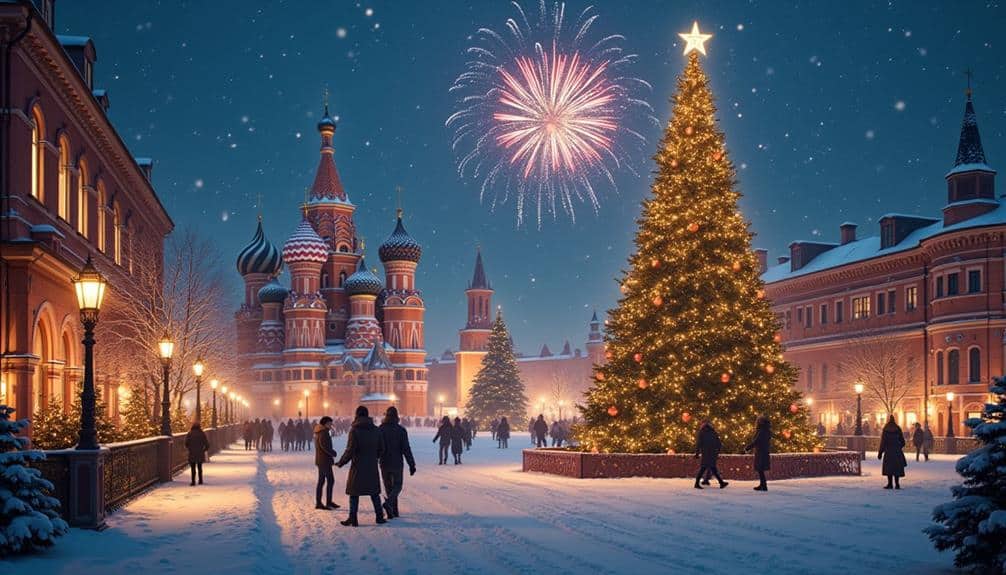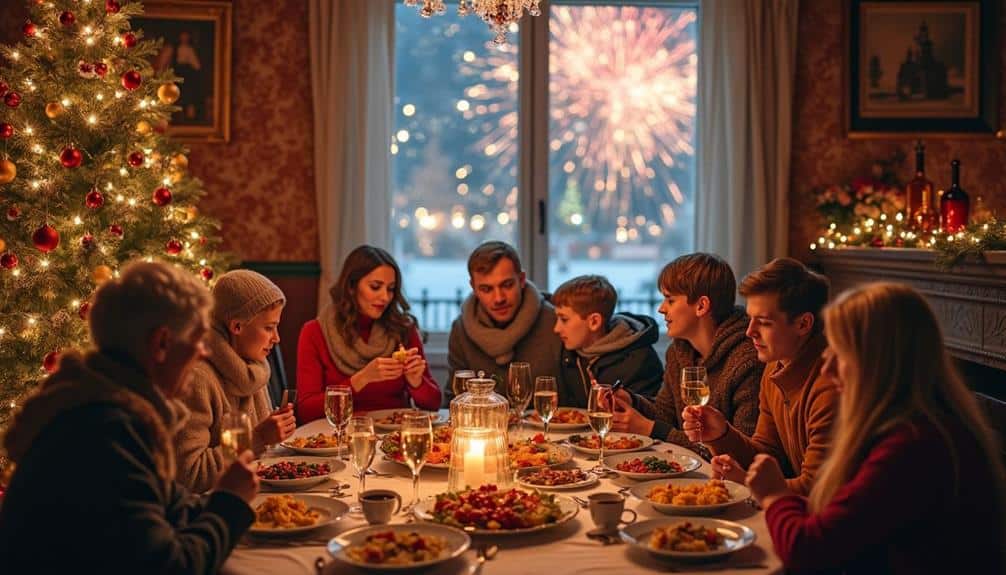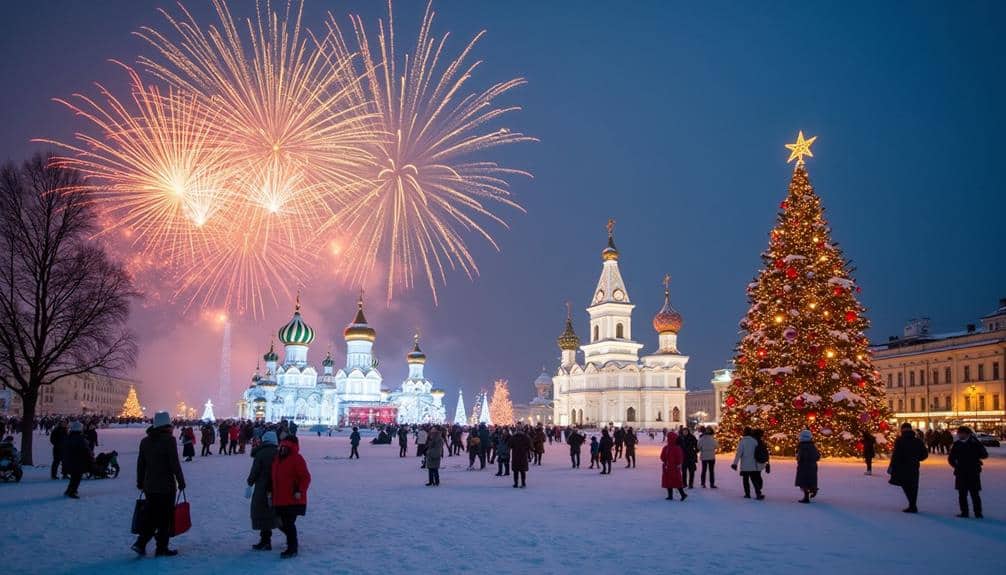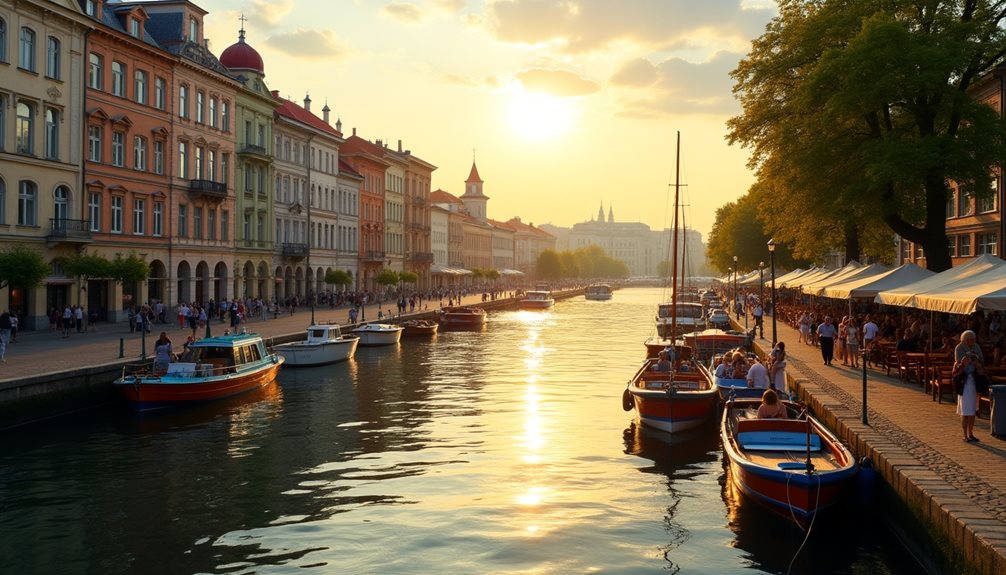The allure of New Year celebrations in Russia is deeply rooted in a blend of historical customs and contemporary practices that create a unique cultural tableau. The seasonal festivities are marked by the presence of Ded Moroz and Snegurochka, figures emblematic of Russian folklore, and the communal gathering around a beautifully adorned yolka. As the clock strikes midnight, families share traditional dishes and heartfelt wishes, embodying the spirit of unity and renewal. Public festivities, including fireworks and cultural performances, further amplify the joyous atmosphere. Yet, what lies beneath these vibrant traditions and how they foster a sense of collective hope is truly fascinating.
Significance of New Year’s Festivities

New Year’s in Russia holds profound cultural and social significance, serving as a cornerstone of national tradition and family celebration. This festive period transcends mere calendar alteration, weaving together historical reverence and communal joy.
For Russians, New Year’s Eve is not just a prelude to a new beginning but a time to reflect, rejuvenate, and reconnect with loved ones. The holiday fosters a spirit of unity and renewal, providing an opportunity to leave behind past grievances and embrace fresh aspirations.
Watch our video conversation on the history of Russia’s New Year, it’s full of interesting information.
The anticipation builds as families gather to prepare elaborate feasts, often featuring iconic dishes like Olivier salad and herring under a fur coat. The importance of this celebration is further amplified by the presence of Ded Moroz, the Russian equivalent of Santa Claus, who brings gifts to children, symbolizing hope and generosity.
Moreover, New Year’s Eve is marked by a nationwide display of fireworks and the President’s annual address, broadcasted to homes across the country. This speech encapsulates the collective aspirations of the nation, reinforcing a sense of shared destiny and resilience.
Essentially, New Year’s in Russia is a multifaceted celebration that honors tradition while embracing the promise of freedom and new possibilities.
Brief History of the New Year Celebration
How did the New Year celebration in Russia evolve into such a significant cultural event? The roots of Russia’s New Year festivities trace back to the early 18th century. In 1700, Tsar Peter the Great issued a decree to shift the celebration of the New Year from September 1st to January 1st, aligning Russia with the Julian calendar used by much of Europe. This significant change marked the beginning of a new era, steering the nation towards a more Europeanized cultural identity.
Throughout the Soviet era, the New Year celebration underwent further transformation. The Bolsheviks’ rise to power in 1917 led to the suppression of religious holidays, including Christmas. Consequently, many of the customs traditionally associated with Christmas were transferred to the New Year celebration, making it a secular but deeply cherished event.
The introduction of “Ded Moroz” (Grandfather Frost) and “Snegurochka” (the Snow Maiden) as central figures of New Year festivities further enriched the cultural tapestry.
Today, the New Year in Russia represents a blend of historical influences and modern aspirations. It is a time when people unite in the spirit of renewal, embodying the freedom to celebrate heritage while embracing contemporary values.
Key Traditions and Customs

Russian New Year celebrations are rich with traditions and customs that reflect the nation’s cultural heritage and modern influences. One of the most cherished customs is the decoration of the New Year tree, or “yolka,” which is adorned with ornaments, lights, and often topped with a star. This practice dates back to pre-revolutionary Russia and is similar to the Western Christmas tree tradition.
A central figure in these celebrations is Ded Moroz, or Grandfather Frost, who, accompanied by his granddaughter Snegurochka (the Snow Maiden), delivers gifts to children. Unlike Santa Claus, Ded Moroz is often depicted in a long, blue or silver coat, emphasizing his wintry origins.
Feasting plays a significant role, with tables laden with traditional dishes like Olivier salad, herring under a fur coat, and sparkling wine. The meal is a time for families to gather, share stories, and enjoy the sense of togetherness.
Another unique custom involves making wishes as the Kremlin clock strikes midnight. Russians write down their wishes on a piece of paper, burn it, and then mix the ashes with champagne to drink, symbolizing the hope and freedom of a new beginning.
Major Celebrations
Among the myriad festivities that mark the Russian New Year, major celebrations stand out for their grandeur and communal spirit. The heart of these celebrations is often found in the family home, where loved ones gather for an elaborate meal.
The dinner table is laden with traditional dishes such as Olivier salad, pickled herring, and sparkling wine, reflecting the nation’s rich culinary heritage. Conversations flow freely, and the atmosphere is one of warmth and kinship.
As the clock nears midnight, the anticipation builds. Televisions across the nation broadcast the President’s annual address, a tradition that unifies citizens in a moment of shared reflection and hope. This is followed by the chimes of the Kremlin’s Spasskaya Tower, signaling the beginning of the New Year.
Fireworks illuminate the night sky, adding a visual splendor that complements the festive mood.
In urban centers like Moscow and St. Petersburg, grand public displays and private gatherings intertwine, creating a vibrant tapestry of celebration. Streets are adorned with twinkling lights and decorations, and the air is filled with the sounds of laughter and music.
These major celebrations embody the essence of freedom, unity, and joy.
Public Festivals Around Russia

Public festivals during Russia’s New Year celebration offer an enchanting array of activities that draw both locals and tourists alike. The streets of major cities, particularly Moscow and St. Petersburg, come alive with vibrant light displays, ice sculptures, and festive markets.
Red Square in Moscow transforms into a winter wonderland, complete with a grand ice rink and towering Christmas tree that invite revelers to skate and soak in the festive spirit.
In addition to the visual splendor, musical performances and cultural shows are integral components of the celebrations. Renowned Russian artists and folk groups perform traditional songs and dances, providing a rich tapestry of the nation’s cultural heritage.
Fireworks displays light up the night sky, creating a mesmerizing spectacle that captivates audiences of all ages.
Public spaces are filled with food stalls offering a variety of delicacies, from blinis to caviar, ensuring that everyone’s palate is satisfied.
For those seeking a more immersive experience, interactive activities such as ice sculpting workshops and traditional craft-making sessions are available, allowing participants to create their own memories.
These public festivals embody the spirit of freedom and joy, making Russia’s New Year celebrations truly unforgettable.
Traditional Films and Shows Watched During Festivities
As the New Year approaches, an array of traditional films and television shows become a staple in households across Russia, serving as a cherished component of the festive season. Among these, the 1975 Soviet romantic comedy “The Irony of Fate, or Enjoy Your Bath!” holds a special place. This film, broadcast annually, tells the tale of a man who ends up in the wrong city after a drunken New Year’s Eve bathhouse gathering, leading to a series of humorous and heartwarming events.
Equally significant is the animated series “Nu, Pogodi!” which captivates audiences with its classic cat-and-mouse-style antics between the wolf and the hare. Its lighthearted and nostalgic appeal makes it a perennial favorite during the holidays.
Television channels also air adaptations of famous Russian fairy tales and folklore, providing a sense of cultural continuity and enchantment. Programs like “Blue Light” (Goluboy Ogonyok) offer a variety show experience, featuring musical performances, comedy sketches, and celebrity appearances, catering to diverse tastes and age groups.
These cherished films and shows are more than mere entertainment; they are a tapestry of shared experiences and memories, weaving together the old and the new in the spirit of freedom and celebration.
Conclusion
The magic of New Year celebrations in Russia, characterized by its rich traditions and communal spirit, exemplifies the nation’s cultural heritage and collective values. The fusion of historical customs, such as the presence of Ded Moroz and Snegurochka, with contemporary festivities, including vibrant public events and traditional media, fosters a sense of unity and renewal. This unique celebration underscores the importance of family, community, and hope, marking a significant moment of cultural and social rejuvenation.




